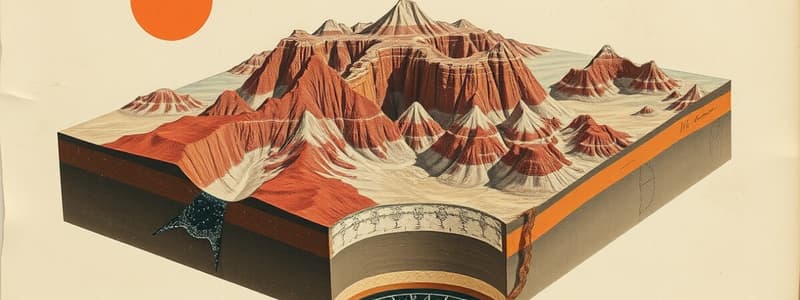Podcast
Questions and Answers
What is the primary process that leads to the formation of mountains as described in the context of plate tectonics?
What is the primary process that leads to the formation of mountains as described in the context of plate tectonics?
- Volcanic eruptions at oceanic ridges
- The collision of tectonic plates (correct)
- The gradual erosion of landforms
- The movement of magma beneath the crust
How do diverging tectonic plates contribute to the formation of landforms?
How do diverging tectonic plates contribute to the formation of landforms?
- They cause the folding of existing rock layers
- They result in ocean trenches and rift valleys (correct)
- They create mountain ranges that rise above sea level
- They trigger volcanic activity characterized by lava flow
What geological feature is predominantly associated with subduction zones?
What geological feature is predominantly associated with subduction zones?
- Mid-ocean ridges
- Rift valleys
- Mountain ranges
- Volcanoes (correct)
Why do earthquakes frequently occur near transform margins?
Why do earthquakes frequently occur near transform margins?
What role does the semi-molten mantle play in plate tectonics?
What role does the semi-molten mantle play in plate tectonics?
What is the primary characteristic of mechanical weathering?
What is the primary characteristic of mechanical weathering?
Which of the following is a cause of chemical weathering?
Which of the following is a cause of chemical weathering?
What happens during frost wedging?
What happens during frost wedging?
Which factor is NOT involved in mechanical weathering?
Which factor is NOT involved in mechanical weathering?
What is the result of oxidation in rocks?
What is the result of oxidation in rocks?
Study Notes
Plate Tectonics Overview
- Earth's crust consists of seven major tectonic plates, plus several smaller ones.
- These plates float on the semi-molten mantle and move slowly, typically a few centimeters each year.
- The movement of tectonic plates plays a crucial role in shaping the Earth's landforms.
Landform Creation by Tectonic Activity
- Diverging Margins: Plates move apart, forming ocean trenches and rift valleys.
- Converging Margins: Collision of plates leads to the formation of mountains and volcanoes.
Volcanoes and Tectonic Plates
- Predominantly located along converging margins or subduction zones.
- Subduction: Occurs when a heavier oceanic plate converges with a continental plate, creating magma that fuels volcanoes (e.g., Mount Pinatubo).
Earthquakes and Tectonic Plates
- Mainly occur near converging plates or along transform margins.
- Transform Margins: Plates slide past each other, can become stuck, and release energy resulting in earthquakes (e.g., San Andreas Fault in California).
Key Activities
- Engage in a jigsaw puzzle of tectonic plates to visualize their arrangement and movement.
- Utilize Geo Skills (PQE) to analyze layers of tectonic activity via an online resource.
Hawaiian Islands Formation
- Study how the Hawaiian Islands emerged from volcanic activity over time, emphasizing the role of shifting tectonic plates and hotspots.
Media Analysis
- Article on Melbourne's recent 2023 earthquake raises questions about trends in seismic activity, significance in relation to plate tectonics, and expert insights.
Understanding Weathering and Erosion
- Weathering is the process of breaking down rocks through water, heat, and cold.
- Results in rocks being worn away, broken down, or dissolved into smaller pieces.
Types of Weathering
- Physical (Mechanical) Weathering: Breakdown of rocks by physical processes without altering their chemical composition.
- Chemical Weathering: Breakdown of rocks due to changes in their chemical structure.
Causes of Mechanical Weathering
- Temperature: Repeated heating and cooling cause rocks to expand and contract, leading to cracks.
- Ice (Frost Wedging): Water enters rock cracks, freezes, and expands, breaking the rocks apart.
- Roots and Plants: Plant roots can grow into rock cracks, causing fractures as they widen.
- Abrasion: Wear and tear caused by wind, water, or other natural forces.
Types of Chemical Weathering
- Hydrolysis: Minerals react with water, causing rocks to decompose (e.g., granite turns into clay).
- Oxidation: Oxygen combines with minerals, creating softer new rock types.
- Carbonation: Carbonic acid in rainwater reacts with minerals, leading to rock weathering.
Erosion
- Erosion is the transport of weathered materials from one place to another by natural forces such as wind, water, ice, or gravity.
- Erosion occurs after weathering, moving broken-down materials across landscapes.
Weathering vs. Erosion
- Weathering: Describes the breakdown of rocks and minerals where they are located without movement.
- Erosion: Involves the movement and transportation of weathered materials to new locations, following weathering.
Interconnection of Weathering and Erosion
- Weathering processes create smaller particles, which are then transported by erosion.
- Both weathering and erosion are crucial for landform development, as illustrated in formations like Antelope Canyon.
Extension Activity
- Create a fact sheet on one of the following locations, detailing which type of weathering contributed to its formation:
- Madagascar Stone Forest: Limestone case study.
- Uluru (Ayer's Rock), Australia.
Studying That Suits You
Use AI to generate personalized quizzes and flashcards to suit your learning preferences.
Description
This quiz focuses on the theory of Plate Tectonics and its role in the formation of mountains and other landforms. As you engage with the material, you'll explore the major tectonic plates and their movements that shape our planet's surface. Be prepared to analyze key information from the accompanying video.




